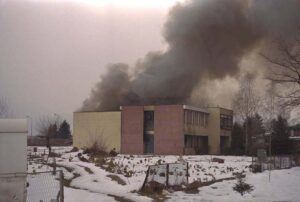The woman piled her books and magazines on the grass in front of her apartment building in the Sarajevo suburb and set them alight. In the crazy logic of her world-turned-upside-down, this meant Serb thugs wouldn’t need to torch her apartment, as they had just done next door.
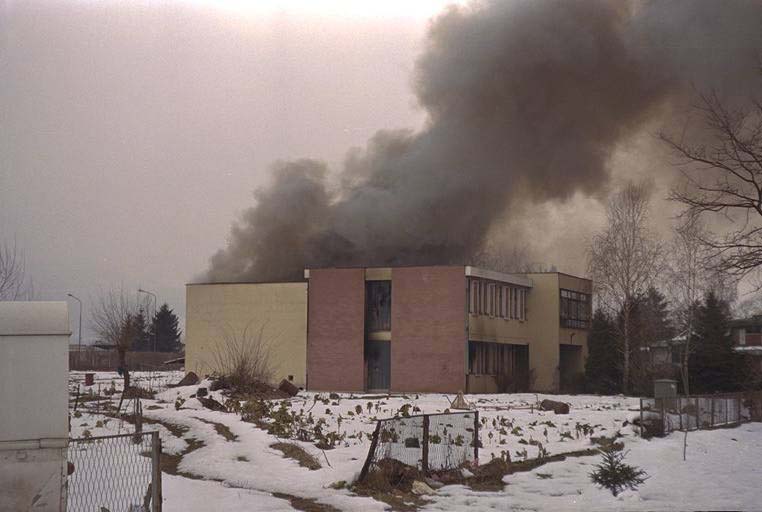
A few blocks away, a 75-year-old man watched as a neighbor leaned out his top-floor apartment window, tossing water upwards from a plastic basin in a vain attempt to extinguish the building’s burning roof. Aleksandar and his wife had managed to escape, but she was in the hospital, and he stood there, hair, eyebrows and eyelashes singed.
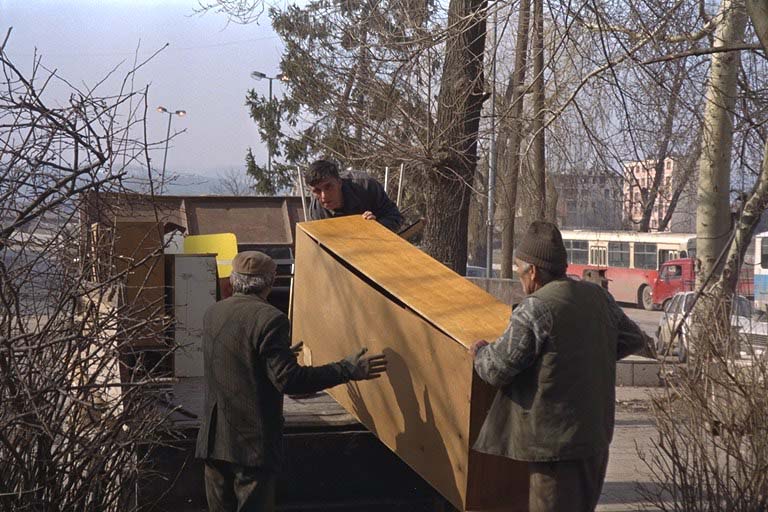
“Fear of Muslims, fear of Serbs, we’re all going to go crazy,” a woman hurrying past shouted, her hands waving wildly in the air.
Grbavica, the last of five Serb areas around Sarajevo being handed over to a Muslim-Croat federation, was in chaos, less than a mile from the headquarters of the 60,000-strong, U.S.-led NATO peace force and the U.N. administration tasked with returning Bosnia to normalcy.
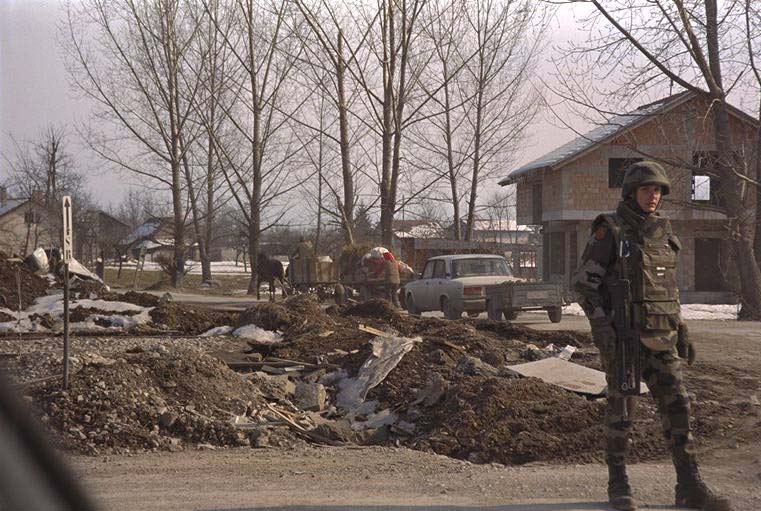
The peace accord, brokered late last year by the United States, had stopped the fighting. But its quick-fix approach to certain key issues, like Sarajevo and war crimes suspects, and a military spooked by the possible consequences of “mission creep” allowed the basic conflict to simmer.
Gangs of thugs and arsonists operated with virtual impunity in the weeks leading up to the handover of the suburbs. They torched homes, factories and schools and threatened anyone challenging the Serbs’ war thesis that Bosnia’s three ethnic groups could not live together. Ethnic segregation was the means by which political leaders throughout ex-Yugoslavia clung to power.
Serbs in the most populous suburb, Ilidza, had tried to challenge their leaders and organized an initiative to encourage fellow Serbs to stay. But when they asked NATO and U.N. police to impose a curfew and protect them from the gangs, they were rebuffed.
“The function of enforcing the law is a matter for the local police,” Peter Fitzgerald, commissioner of the U.N. international police monitors, told a March 9 townhall meeting in Ilidza. “Despite what you may wish, we simply do not have the authority to arrest people.”
The 100 mostly elderly Serbs in the audience were incredulous. To the extent they still existed, the local Serb police were doing nothing, and the international community knew it. U.N. and NATO officials had even accused some police of involvement in this last wave of “ethnic cleansing.” In Grbavica, just 200 yards from the old front line with downtown Sarajevo, the terror had turned deadly. One elderly Muslim woman had her brains blown out, and a young Serb mother committed suicide with a hand grenade as her infant son lay nearby.
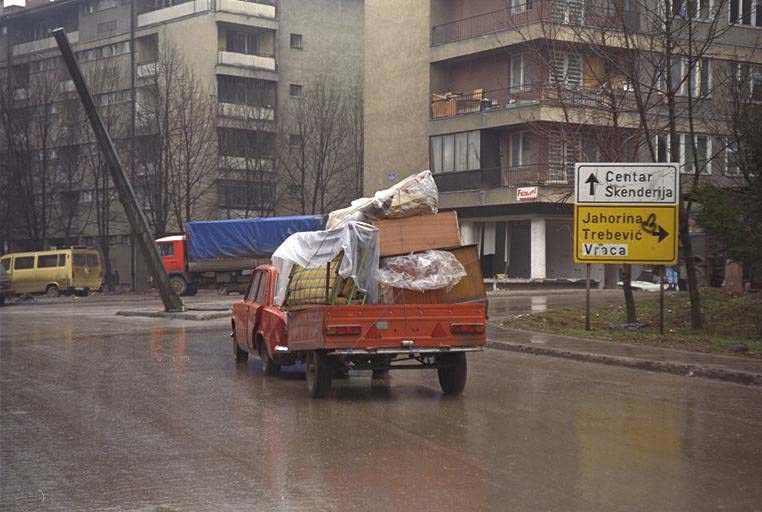
But Fitzgerald was right. The Bosnian peace plan, hammered out in three weeks of closed-door talks in Dayton, Ohio, had not made clear provisions for the civilian law-and-order breakdown likely to result between the end of war and the creation of peacetime institutions. The result was a vacuum of authority and security.
NATO officials repeatedly blamed the “parties” for not carrying out the agreement in good faith. But Serbs had no interest in stopping the terror.
And Muslim-Croat federation police, whose own commitment to multiethnicity was later questioned, were not allowed to deploy until the suburbs had been transferred.
“You can’t allocate responsibility to entities that don’t exist and won’t exist for some time, and that’s what Dayton did,” one NATO officer complained.
Of the approximately 1,700 international police monitors pledged by U.N. member nations, less than 500 were in Bosnia for the critical territorial handover period. With no power of arrest, the unarmed monitors, assisted by NATO, simply handed over suspected thugs to local police, who immediately released them.
Only NATO had the right to detain suspects, at least 72 hours, something it didn’t publicly acknowledge until the day before the final suburb hand-over. But the Americans, and thereby NATO, were ruled by fear of “mission creep,” of doing anything beyond a strict military task that might draw forces into a civilian morass like Somalia.

“IFOR is not going to put itself in the position to be the de facto police force,” insisted Maj. Simon Haselock, a spokesman for the Implementation Force, or IFOR.
The message to the Serb residents was clear: no one would protect you. So most of them fled.
“We got it wrong because we didn’t foresee the problems,” the NATO officer said, “and Dayton got it wrong because of a total failure to understand this country and its problems.”
Muhamed Sacirbey, the U.S.-educated Bosnian government official who was part of the Sarajevo delegation at the Dayton talks, is among those who believe many details were glossed over in the rush to secure a peace deal. There was a one-year limit on U.S. military involvement, and troops had to be on their way out of Bosnia by the November 1996 presidential election.

“The unfortunate point is that Dayton was played out as a poker game instead of as intellectual dialogue. Now my opinion is that some poker was necessary. But the poker game was the predominant factor, and a lot of it had to do with who Dick Holbrooke is,” Sacirbey said, referring to the former U.S. assistant secretary of state who secured the deal.
“Dick Holbrooke is a brilliant person, a good negotiator, but he doesn’t want to know details. As he says, he didn’t want to be bothered by them,” said Sacirbey, Bosnia’s U.N. ambassador. “But it’s the details that I think most tellingly will impact the future and the sustainability of the peace.”
Establishing Sarajevo as a federal capital, similar to Washington, D.C., and effectively making it a third entity in the ethnic division of the country had been considered. Supporters of the idea believed Sarajevo could serve as a link between the Muslim-Croat and Serb entities, thereby forcing them to interact.
Militarily, however, a unified Sarajevo was deemed easier to implement. So when Serbian President Slobodan Milosevic, negotiating on behalf of his erstwhile proteges, unexpectedly offered to relinquish the Serb suburbs and unify the capital it was a neat solution.
“He assured his interests and promoted division,” a senior European diplomat said of Milosevic. “It was easier to implement, but politically it was the wrong solution if you want to keep this country together.”
Far from being a glitch in the implementation of the peace accord, what happened in Sarajevo’s suburbs could have lasting consequences.
“This has been a huge blow to the whole idea of multiethnicity not only of Sarajevo but the entire country, and it will have an impact on whatever happens here in the future,” said Kris Janowski, a Bosnia veteran of the U.N. High Commissioner for Refugees. “We have already had signals from the Serb representatives that the exodus of Serbs from Sarajevo is being used as an excuse not to allow Muslims back into their homes.”

The right of refugees to return home is a basic tenet of Dayton and key to lasting peace.
Janowski said ramifications would also likely be felt in the shaky Muslim-Croat federation, especially in places like Mostar, Bosnia’s Berlin.
Critics of the Dayton accord say its weakest point is its reliance on the Muslim-Croat federation as a cornerstone and a counterweight to the Serbian Republic, between which Bosnia is divided territorially. The March 1994 Washington Agreement that created the federation was largely a cease-fire accord. It also opened a weapons route to the landlocked Muslim-led Bosnian Army.
So weak is the federation that the two sides used the issue of police uniforms and their color to block integration of Muslims and Croats in the federal police forces that moved into Sarajevo’s Serb suburbs.
NATO and the United Nations accused the Bosnian government of doing too little to calm Serbs fears about staying and of paying lip service to the ideal of multiethnicity, especially after federation police stood by while Muslims gangs briefly terrorized Serbs following the handover of Ilidza.
But Sacirbey insisted there was little the Bosnian government could have done to counteract the Serb “ideology… that in fact Serbs could not live together with Muslims and Croats.”
That ideology has survived Dayton in large part because the Bosnian Serbs’ top two leaders, Radovan Karadzic and Gen. Ratko Mladic, continue to call the shots, despite being indicted for war crimes by the Hague tribunal. Dayton prohibits them only from holding or running for office.
NATO, mindful of “mission creep” parallels with Somalia, has refused to hunt down the indicted war criminals. But even when its officers crossed paths with Karadzic in the northern town of Banja Luka in late February, NATO declined to act.
Bosnian government leaders worry that Karadzic and Mladic, by proxy, will use the political authority Dayton gives the Serbs to achieve the territorial partition they failed to win in war.
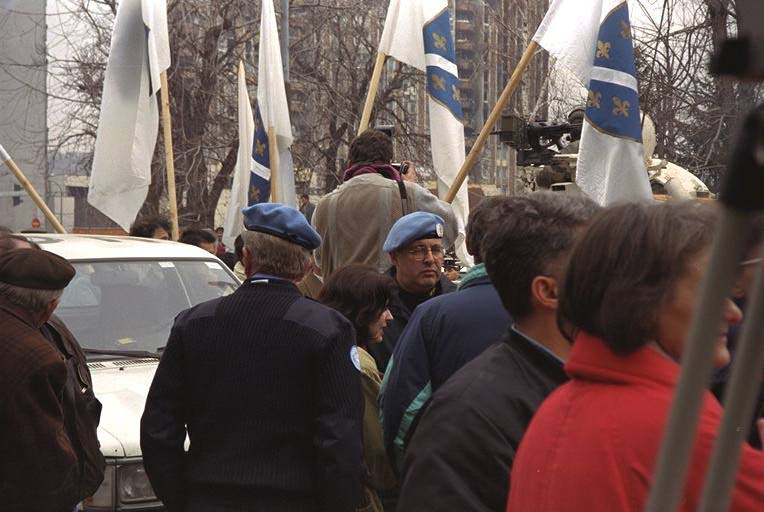
The U.S. Defense Intelligence Agency said in late March “the overall strategic political goals of the former warring factions have not fundamentally changed.” It warned that unless significant amounts of reconstruction aid began flowing into Bosnia the chances of a lasting peace were “dim.”
Most of the major reconstruction projects extend across ethnic lines, and the belief is that money will knit Bosnia back together in ways diplomacy cannot.
To that end, NATO announced it would expand, slightly, its military mission to helping rebuild some of Bosnia’s infrastructure, like roads and bridges.
“If the civilian side of this thing goes belly up then no amount of work on NATO’s part is going to be seen as successful,” U.S. Adm. Leighton Smith, NATO’s senior commander in Bosnia, acknowledged.
But money has been slow in coming, with only a fraction of the estimated $1.8 billion needed for 1996 pledged at the plan’s three-month mark. The overall reconstruction bill is estimated at over $5 billion.
“Money is the only hope,” said a senior Commerce Department official after visiting Sarajevo. “If you have a shovel in your hand you don’t have a rifle in your hand.”
Reconstruction was the object of Commerce Secretary Ron Brown’s fateful mission to Croatia. The businessmen and women who perished with him when their plane crashed were bringing the hope of economic rejuvenation.
Despite the Commerce Department’s vow to continue Brown’s efforts and a new trip planned for July, a strong air of pessimism permeates Sarajevo.

“I think in a few years this will be a mess and this will have been a staggering waste of time, effort and money,” said the NATO officer. “The whole thing will flare up again, one way or another. I honestly cannot see anything coming out of this lasting very long.”
©1996 Maud S. Beelman
Maud Beelman is an Associated Press correspondent in Vienna on leave who is researching U.S. foreign policy in the former Yugoslavia.

